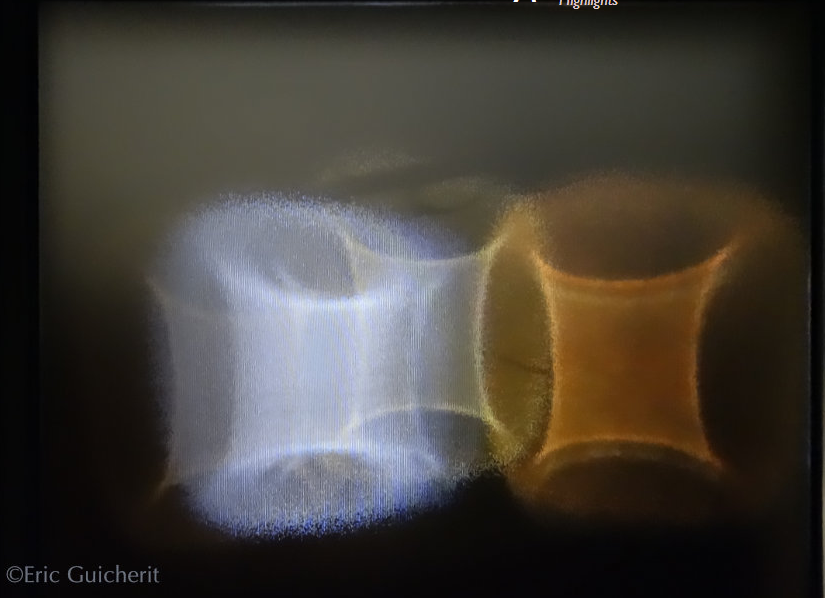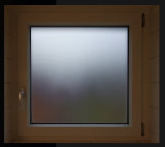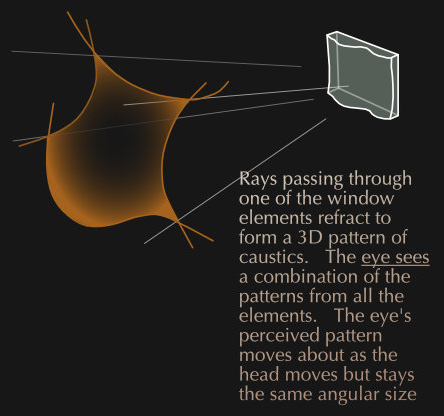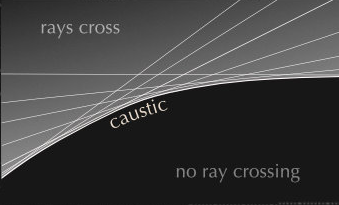Light Patterns, Caustics
Light Patterns, Caustics: Unveiling the Magic of Refraction
Light patterns and caustics have captivated our imagination for centuries. These mesmerizing phenomena occur when light interacts with various surfaces, creating intricate patterns and shapes that seem to dance before our eyes. In this article, we will delve deeper into the world of light patterns and caustics, exploring their origins, characteristics, and the scientific principles behind them.
The Dance of Floating Light Patterns
One fascinating example of light patterns can be observed when a sodium street lamp and a neighboring white light shine through a double-glazed window. As Eric Guicherit discovered, these lights form enchanting floating patterns that seemingly follow his movements. Regardless of his position, the angular size of these patterns remains constant. As he moves away from the window, the patterns gradually fill the entire frame, enveloping him in their luminous embrace.
The Inner Workings of Caustics
To understand the origin of these captivating shapes, we must first examine the structure of the double-glazed window. The inner pane is made of plain glass, while the inner surface of the outer pane features an array of rounded projections. These projections, known as lens elements, refract light from external point-like sources. The outgoing refracted rays converge in specific areas, giving birth to the bright curves and caustics that form the intricate patterns we observe.
Caustics: A Symphony of Many
Contrary to popular belief, the caustic shapes we see are not formed by a single lens element. Instead, they emerge from a combination of numerous elements that happen to align at the right angular positions. This phenomenon is similar to how a rainbow is created by countless raindrops dispersing and refracting sunlight. Each element contributes its own unique pattern to the overall tapestry of light, resulting in the ethereal display that enchants our senses.
A Multidimensional Kaleidoscope
When rays pass through one of the window elements, they refract and form a three-dimensional pattern of caustics. Our eyes perceive a composite of these patterns from all the elements, creating the illusion of movement as we shift our perspective. The perceived pattern dances and shifts with the movements of our head, yet its angular size remains constant, adding to the mystique and wonder of this visual spectacle.
Unveiling the Secrets of Refraction
To gain further insight into the formation of caustics, let us turn to the realm of computer ray tracing. In this simulated environment, parallel rays from the air enter a wavy glass surface. As these rays refract, those entering convex parts of the glass converge and cluster together. The intensity of light in these clustered areas increases proportionally to the tightness of their convergence. The boundary between the clustered and un-clustered rays manifests as a caustic, marking a topological discontinuity in space.
Caustics: Everywhere We Look
Caustics are not limited to the confines of our bathroom windows; they are ubiquitous in our surroundings. We encounter them in the form of rainbows, those magnificent arcs of refracted light that grace the sky after rainfall. They also manifest as the bright, seemingly random lines we observe in swimming pools, created by wave reflections playing on the surfaces of boat hulls. Even the twinkling stars above us owe their shimmering beauty to the intricate dance of caustics in the Earth's atmosphere.
The Magic Continues
The exploration of light patterns and caustics is an ongoing endeavor. Scientists and researchers continue to unravel the mysteries behind these mesmerizing phenomena, shedding light on the intricate interplay between light and matter. As we delve deeper into the world of optics, we uncover new insights that not only enhance our understanding of nature but also inspire awe and wonder at the intricacies of the universe.
So, the next time you gaze out of a window and witness the dance of light and shadow, take a moment to appreciate the enchanting caustics that grace your surroundings. In these ethereal patterns, we catch a glimpse of the captivating beauty that lies at the intersection of science and art, reminding us of the boundless wonders that await our curious minds.

Floating Light Patterns
Eric Guicherit imaged these floating patterns. A sodium street lamp and a
neighbour's white light shone through his bathroom window to form them.

They moved with him and always stayed the same angular size. As he moved away from the window they eventually filled it.

The window is double glazed. The inner pane is plain glass. The outer pane's inner surface is an array of rounded projections. These do form crude images (below left). However, Eric's odd shapes are not lens images. They are caustics so named from the Greek KauσTIKós, to burn.
Each array element refracts light from a external point-like light source. The outgoing refracted rays bunch together in some places to form the bright curves, caustics, of the patterns.
The caustic shapes seen are not from a single element. All the elements that just happen to be in the right angular position make up the pattern. Just like a rainbow is made by many many raindrops.

Rays passing through one of the window elements refract to form a 3D pattern of caustics. The eye sees a combination of the patterns from all the elements. The eye's perceived pattern moves about as the head moves but stays the same angular size

In this computer ray tracing, parallel rays from air at right enter a wavy glass surface.
Rays refract. Rays entering parts convex towards the right converge in the glass and cluster together. The tighter they cluster, the more intense is the light there. The boundary between the clustered and un-clustered rays is a caustic.
More precisely, a caustic is a line or surface that separates an area of space where rays cross from space where they do not. It is a topological discontinuity.
Caustics are all around us. Rainbows. The bright not quite random lines in
swimming pools. Wave reflections playing on boat hulls. Twinkling stars
Note: this article has been automatically converted from the old site and may not appear as intended. You can find the original article here.
Reference Atmospheric Optics
If you use any of the definitions, information, or data presented on Atmospheric Optics, please copy the link or reference below to properly credit us as the reference source. Thank you!
-
<a href="https://atoptics.co.uk/blog/light-patterns-caustics/">Light Patterns, Caustics</a>
-
"Light Patterns, Caustics". Atmospheric Optics. Accessed on November 26, 2024. https://atoptics.co.uk/blog/light-patterns-caustics/.
-
"Light Patterns, Caustics". Atmospheric Optics, https://atoptics.co.uk/blog/light-patterns-caustics/. Accessed 26 November, 2024
-
Light Patterns, Caustics. Atmospheric Optics. Retrieved from https://atoptics.co.uk/blog/light-patterns-caustics/.